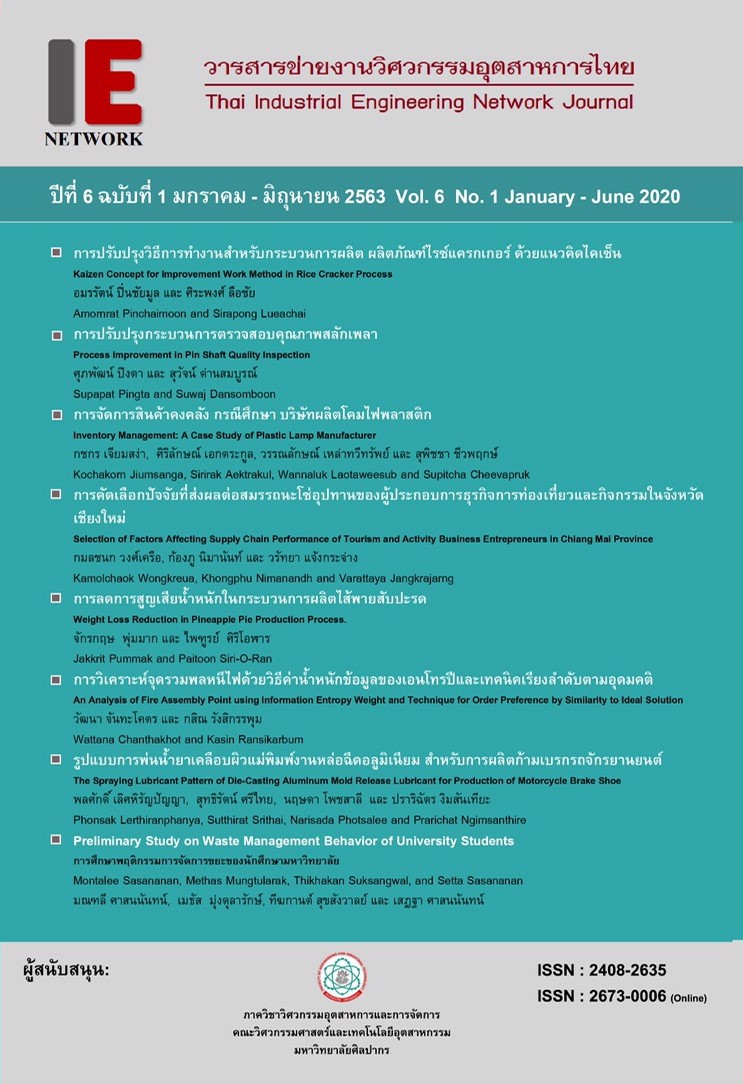An Analysis of Fire Assembly Point using Information Entropy Weight and TOPSIS
Main Article Content
Abstract
In this research, we analyze the suitability of the fire assembly point using the multi-criteria decision analysis technique for a case study of the home appliance factory. The case study comprises of 4 possible assembly points and 5 buildings that may be the start of fire. Initially, we evaluate the relative weight of seven key criteria deemed important for the selection of the fire assembly point, which are 1) the distance between a working area under fire and an assembly point, 2) the capacity of an assembly point, 3) the distance between harmful fire sources and an assembly point, 4) the distance between an exit of the factory area and an assembly point, 5) the width of the main road connected to an assembly point, 6) the number of possible routes connected to an assembly point, and 7) the distance between a medical room and an assembly point. The Information Entropy Weight technique is then used to evaluate the criteria weight based on the intensity of available data. Our analysis shows that the most important criterion is the distance between an exit of the factory area and an assembly point, whereas the width of the main road connected to an assembly point is the least important criterion. Next, we analyze four possible assembly points using the Technique for Order Preference by Similarity to Ideal Solution (TOPSIS) and find that the second assembly point being an area in front of the cafeteria close to the guard house of the case study is the best alternative. The results from this study can be applied to fire evacuation planning and to selection problems for muster points of other facilities.
Article Details
บทความ ข้อมูล เนื้อหา รูปภาพ ฯลฯ ที่ได้รับการตีพิมพ์ในวารสารฯ ถือเป็นลิขสิทธิ์ของวารสารฯ หากบุคคลหรือหน่วยงานใดต้องการนำทั้งหมดหรือส่วนหนึ่งส่วนใดไปเผยแพร่ต่อหรือเพื่อกระทำการใดๆ จะได้รับอนุญาต แต่ห้ามนำไปใช้เพื่่อประโยชน์ทางธุรกิจ และห้ามดัดแปลง
References
[2] เอกสารความปลอดภัยและอาชีวอนามัย การอพยพหนีไฟ สถาบันส่งเสริมความปลอดภัย อาชีวอนามัย, ข้อมูลจาก www.tosh.or.th (วันที่สืบค้นขอ้มูล 5 พฤษจิกายน 2562)
[3] แผนป้องกันและระงับอัคคีภัย บริษัท ปตท จำกัดมหาชน, ข้อมูลจาก www.eia.onep.go.th/ (วันที่สืบค้นขอ้มูล 9 กุมภาพันธ์ 2563)
[4] แผนป้องกันและระงับอัคคีภัย สํานักส่งเสริมและการศึกษาต่อเนื่องมหาวิทยาลัย สงขลานครินทร์, ข้อมูลจาก www.exten.pn.psu.ac.th/ (วันที่สืบค้นขอ้มูล 9 กุมภาพันธ์ 2563)
[5] กรมป้องกันและบรรเทาสาธารณภัย กระทรวงมหาดไทย, คู่มือประชาชนในการเตรียมตัวให้รอดปลอดภัยพิบัติ. บริษัท เวิร์ค พริ้นติ้ง จำกัด, นครปฐม, 2560
[6] Guidance Document – Fire Assembly Points, , ข้อมูลจาก www.kerryfireandrescue.ie/ (วันที่สืบค้นขอ้มูล 10 กุมภาพันธ์ 2563)
[7] Fire Evacuation Procedures: Choosing an Assembly Point, ข้อมูลจาก www.fireaction.co.uk/ (วันที่สืบค้นขอ้มูล 10 กุมภาพันธ์ 2563)
[8] Ransikarbum, K., and Mason, S. J., Multiple-objective analysis of integrated relief supply and network restoration in humanitarian logistics operations, International Journal of Production Research, 54(1), 49-68, 2016
[9] Ransikarbum, K., and Mason, S. J., Goal programming-based post-disaster decision making for integrated relief distribution and early-stage network restoration. International Journal of Production Economics, 182, 324-341, 2016
[10] วัฒนา จันทะโคตร และกสิณ รังสิกรรพุม, การศึกษาประสิทธิภาพการจัดการอัคคีภัยในประเทศไทยด้วยการวิเคราะห์แบบล้อมกรอบข้อมูล, วารสารวิจัย มข., 20(3), กรกฎาคม-กันยายน, 2563
[11] นิรุทธิ์ วัฒนะแสง และกสิณ รังสิกรรพุม, การเลือกที่ตั้งนิคมอุตสาหกรรมเขตเศรษฐกิจพิเศษชายแดนไทยด้วยเทคนิคการวิเคราะห์แบบล้อมกรอบข้อมูล, วารสารวิศวกรรมศาสตร์ ม. อุบลราชธานี, 13, 2563
[12] Chaiyaphan, C., and Ransikarbum, K., Criteria Analysis of Food Safety using the Analytic Hierarchy Process (AHP)-A Case study of Thailand’s Fresh Markets. In E3S Web of Conferences (Vol. 141, p. 02001). EDP Sciences, 2019
[13] Khamhong, P., Yingviwatanapong, C., and Ransikarbum, K., Fuzzy Analytic Hierarchy Process (AHP)-based Criteria Analysis for 3D Printer Selection in Additive Manufacturing. In 2019 Research, Invention, and Innovation Congress (RI2C) (pp. 1-5). IEEE, 2019
[14] กิตติ วิเศษลา และกสิณ รังสิกรรพุม, การวางแผนกระบวนการผลิตชิ้นงานสามมิติด้วยวัสดุ ABS ในเครื่อง FDM ภายใต้การวิเคราะห์แบบล้อมกรอบข้อมูลและเทคนิคการเรียงลำดับการตัดสินใจ, วารสารวิทยาศาสตร์และเทคโนโลยี มหาวิทยาลัย อุบลราชธานี, 22(1), มกราคม – เมษายน, 2563
[15] Ho, W., Integrated Analytic Hierarchy Process and Its Applications- A Literature Review, European Journal of Operational Research, 186, 211 228, 2008
[16] Li, X., Wang, K., Liu, L., Xin, J., Yang, H., and Gao, C., Application of the entropy weight and TOPSIS method in safety evaluation of coal mines. Procedia Engineering, 26, 2085-2091, 2011
[17] Verdu, S., Fifty years of Shannon theory. IEEE Transactions on information theory, 44(6), 2057-2078., 1998
[18] Hwang, C. L., and Yoon, K., Methods for multiple attribute decision making. In Multiple attribute decision making (58-191). Springer, Berlin, Heidelberg, 1981
[19] National Fire Protection Association, NFPA 101, Life safety code, National Fire Protection Association, Massachusetts, USA., 2009
[20] วิศวกรรมสถานแห่งประเทศไทย. EIT Standard 3002-51. มาตรฐานการป้องกันอัคคีภัย,วิศวกรรมสถานแห่งประเทศไทย, กรุงเทพฯ, 2551


